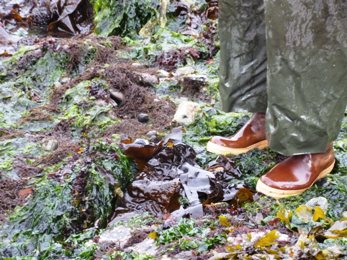by Cara Russell
The rain came on strong last Monday morning, June 24, when Food Masters invited Ryan Drum to hold a class to explain just what benefits seaweed has to people in the Camp Orkila Seaweed Scramble.
Nearly 30 individuals gathered in the parking lot at Camp Orkila, clutching their empty plastic buckets, waiting to harvest their 10 wet pounds of seaweed. When Drum arrived, the parade made its way down to the beach. People shared umbrellas, and bit their lips as they withstood the cold rain and wind.
So what is Seaweed to us? We’ve all played with it as children. Thrown softball sized handfuls of it at our siblings, used bullwhip kelp as though it were the real deal, our parents yelling at us to put the slimy stuff down. For most our exposure goes no further than viewing it as an alien goo laying on the beach. But seaweed is a vegetable, a salt-tolerant land plant, growing on sand and rocks, exposed when the tide’s low.
Drum explained what seaweed can contribute to our gardens, how to harvest it, and the risks and benefits of ingesting it.
“All Seaweeds are edible, pickle-able, but not all are palatable.” said Drum with a smile. “And with seaweed having a zero shelf life, it is best to attempt pickling, drying, or just eating it immediately;” he chewed on a piece of Saragassum. And why not eat it? Seaweed is rich with minerals and vitamins such as Iodine, calcium, sodium, magnesium, potassium, iron, zinc, copper, and selenium, and also contain essential fatty acids.
Black Seaweed is the easiest to eat. It grows attached to rocks in thin, almost transparent sheets of green to nearly black. Paper thin, it can shred easily if not handled gently. With almost no flavor, it is the most edible.
Rockweed is the most common and abundant on our beaches. It attaches and grows on rocks, brown in color, with pockets of air bubbles at its tips. When the sacks are popped it secretes a gel, which can be used as a lotion, moisturizer, or to soothe sunburns.
Bullwhip Kelp, true in appearance to its name, can grow up to 90‘-100‘, and is a perfect sea-vegetable for pickling. Next time you are having a sandwich, try a piece of pickled Bullwhip Kelp instead of your usual pickled cucumber.
Sargassum, known as Japanese Seaweed is a newer resident to our waters. It was introduced over fifty years ago to the Pacific North West, when it hitched a ride with imported oysters from Asia. This is a rapid growing seaweed, and there has been concern as well as action taken towards the plants invasive nature. Sargassum does have some benefits as well, it’s high in iodine and has been used, to help supplement the treatment of thyroid disorders.
Seaweed has also been found to help smokers curb their addiction. And if eaten properly, it can help in preventing tumor growth and/or spreading.
When harvesting it is important not to pick any plants that are unattached, thus if it’s just laying in the sand, it’s not a good choice. Rinse the seaweed well in salt water to remove sand, then place in a container.
Seaweed is also wonderful in the garden. It works as an organic fertilizer, keeps moisture in the earth, repels slugs (who hate salt), enriches the soil, and is high in carbohydrates which stimulates plant growth. When using seaweed to mulch your garden, Drum suggests accompanying it with something dry like hay, straw, or maple leaves to absorb runoff. If your are concerned about getting too much salt in your soil, you can rinse the seaweed in fresh water, but Drum doesn’t.
The San Juan Islands are rich in resources, and it’s no wonder many people make the trek to our islands every year. With over-harvesting and water pollution becoming a growing problem, the classes offered through Food Masters, are a good source of information for beginners and masters alike in taking another step toward learning more about our home, what it can offer us, and what we can do in return.
More information about FoodMasters is available at the website, www.IslandFoodMasters.org.
**If you are reading theOrcasonian for free, thank your fellow islanders. If you would like to support theOrcasonian CLICK HERE to set your modestly-priced, voluntary subscription. Otherwise, no worries; we’re happy to share with you.**










I love seaweed. Thanks for the article, Cara.
I also love seaweed, but one has to be careful of the phytoplankton that occasionally show up in this area. Although they may not actually invade the seaweed, the bad ones can leave their traces on the seaweed. Either know whether alexandrium (causing paralytic shellfish poisoning) is in the area or wash your seaweed before eating.
A few years ago before I really knew much about the little critters that inhabit our waters sometimes, I picked up a wonderful piece of seaweed and started to eat it …. ooh-la-la what immediate numbness hit me. Just be a bit careful and aware.
you could look it up, as Yogi said…Ryan Drum has online info galore. It was a most interesting ramble, in spite of the downpour, and seaweed is definitely on the menu in my house, now.
There have been algae blooms around Orcas, definitely Eastsound; so it is good to check with officials before harvesting anything…clams, seaweed, anything..and be sure to have your license with you.
Thanks for sharing your knowledge with us, Ryan.
The word is Slowly getting out there,pay att. to the kinds!I harvest 20 kinds to eat daily and cap my daily intake.Watch the japan pollution and be sure to know where the seaweed came from before eating,great work,thanks Dan